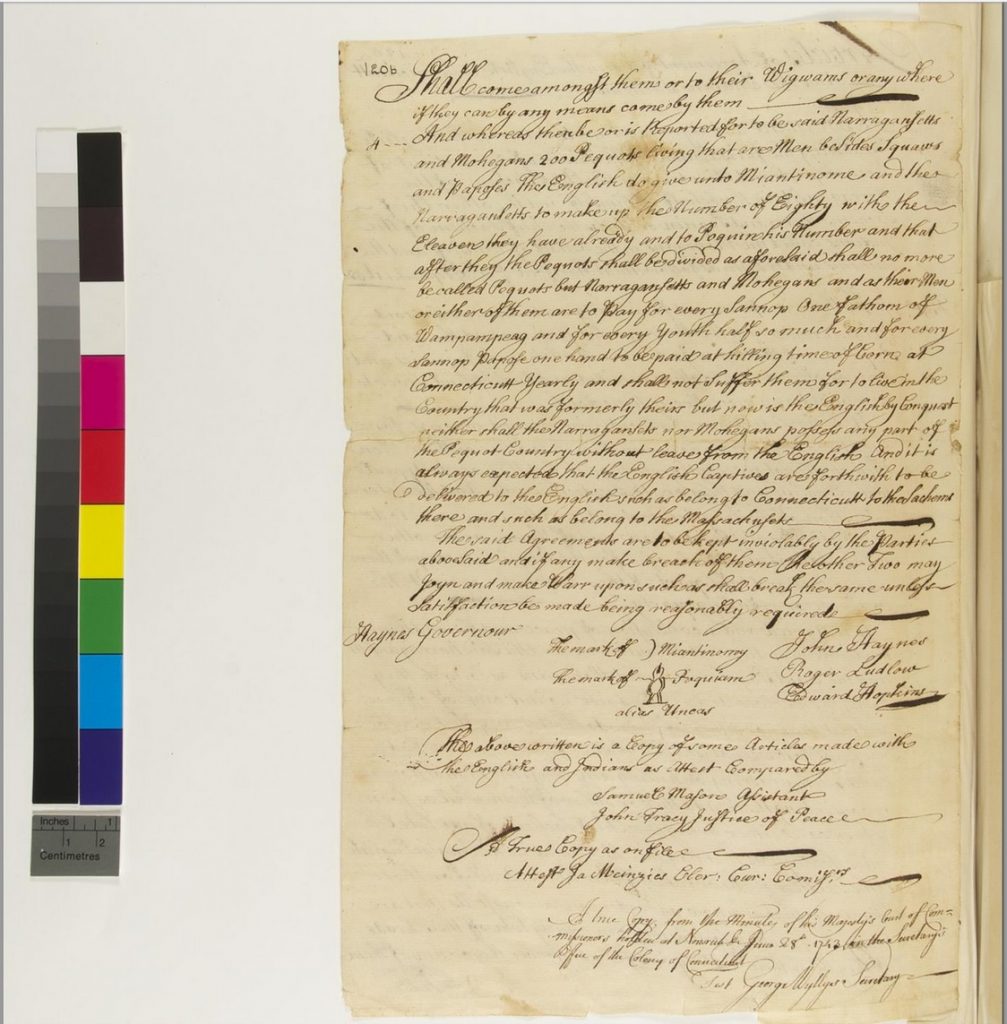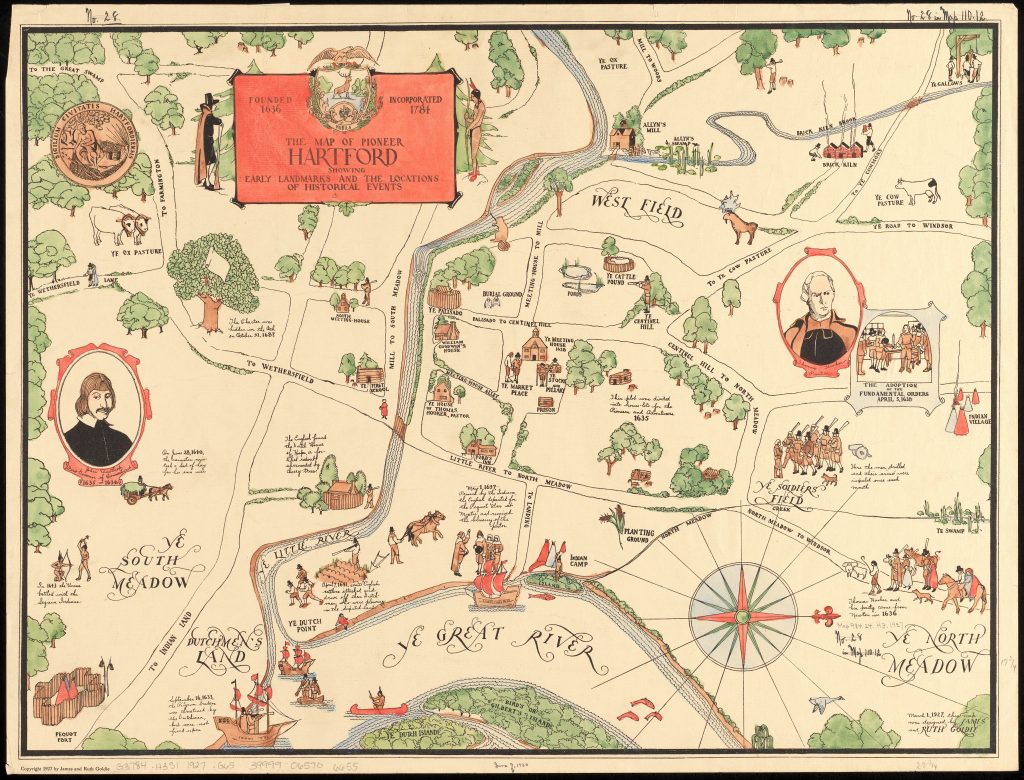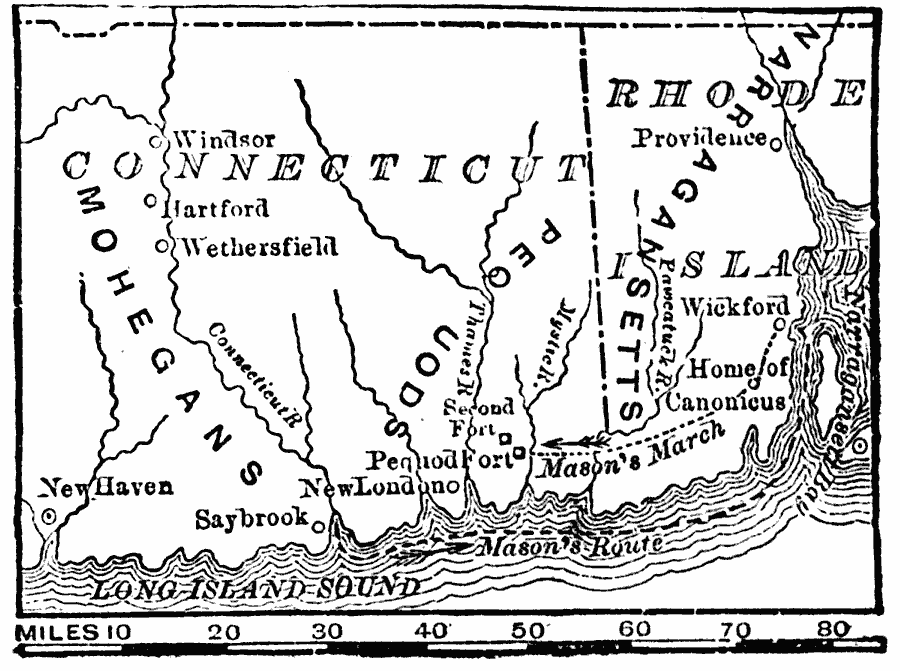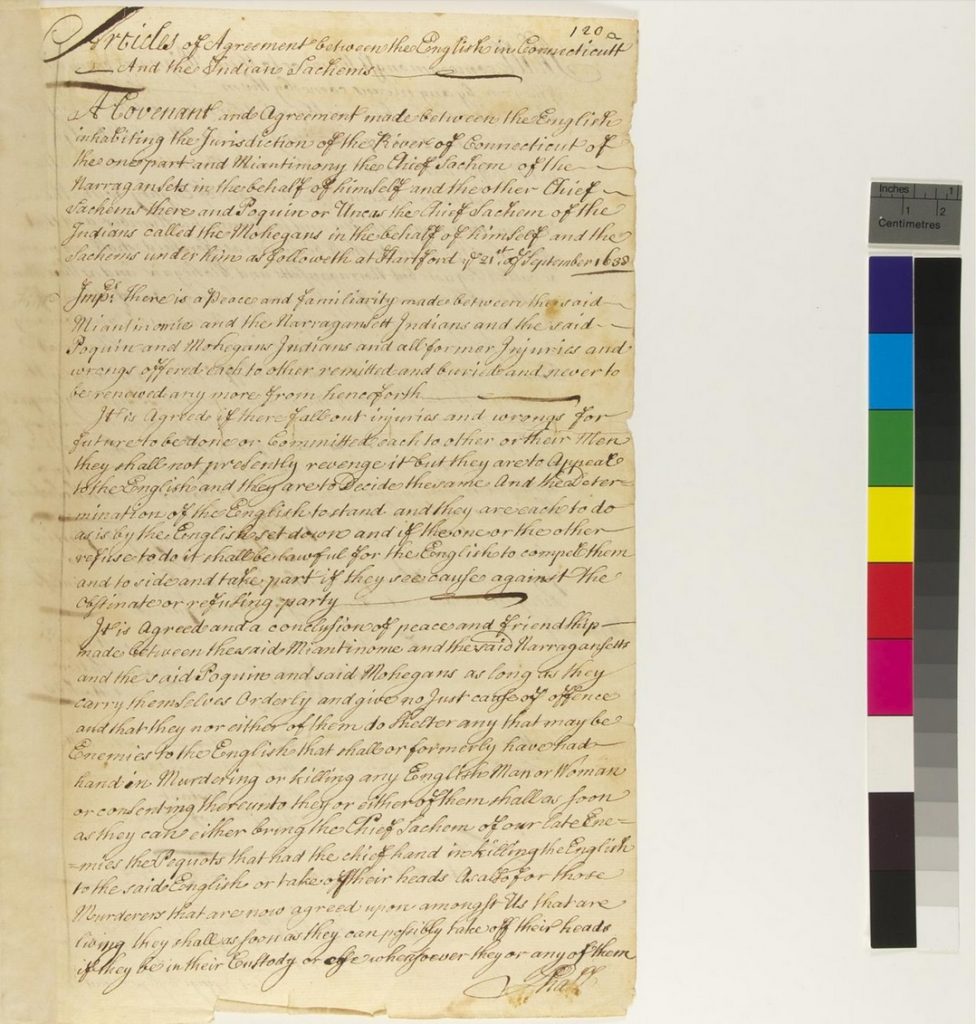Introduction:
In 1639 delegates from the major sovereignties of the Connecticut region, met in a small English settlement along the Connecticut River. The reason for the meeting was to sign a treaty ending the war that had raged in the area for the last two years. The parties involved, the English, the Mohegans, and the Narragansets, signed the treaty whose title bore the name of the settlement it was signed in, Hartford. Yet, there was one party missing from the treaty, the Pequots, who lost the war and who would suffer under the strict regulation placed upon them by the Treaty of Hartford. The Pequot tribe had dominated the Connecticut region before the English had set foot in the valley, yet after losing the war to the combined English, Mohegan and Narragansett alliance, the remainder of the tribe was either scattered or sold to slavery. In this essay, I will discuss the background, the terms and, the aftermath of the Treaty of Hartford with an emphasis on the Pequots and the punishments that they suffered.
The European's Arrival
In 1633, the only European claim to the region was a small fort along the Park River (also known as the Hog River) in what is today the city of Hartford. While today the river is hidden from view buried underneath modern-day Hartford, the river used to run parallel to the mighty Connecticut River. This Fort, called Huys de Hoop (also known as Fort Good Hope) garrisoned 15 men. The purpose of this fort was to serve as a trading post for the exchange of European goods for Native Wampum. The Dutch had found that these beads and jewelry were similar to that of currency and could be traded for furs and special resources with other native groups. In order to do this, the Pequot granted to the Dutch the land along what is today the Park River to trade with the northern tribes and the Pequot alike.
The English arrived shortly after, in 1634. They settled across the Park River, adjacent to the Fort Good Hope. The settlers, having sailed from England, named this settlement after their far-off home, Hartford. The colony, despite the lack of Charter or land agreement, began setting up smaller settlements along the river and broke away from the Massachusetts Bay Colony, forming the Connecticut River Colony, again despite its legality.
The Native Inhabitants:
The native groups in the region had little said in the matter. The Connecticut River Valley Indians were paying tribute to the Pequots who, as mentioned before, were the main power in the area. The Mohegans and the Narragansetts were powerful neighbors to the Pequots. The Mohegan were located in the North and the Narragansett were located in modern-day Rhode Island. Both of these tribes had their own displeasures with the militarily dominant Pequot. The Mohegans, in particular, had a long history of conflict deriving from when the original Pequots had broken away from their tribe.
The Spark:
While the Pequots were not pleased with the new English settlers, there seemed to be no real disagreement or conflict between the two, that is, until the Massachusetts Bay Colony raided one of their villages. In a personal interview with historian and researcher for the Mashantucket-Pequot Museum on April 18th, 2019, David Naumec shared with me the events of the meeting and how the war was escalated from the point of view of the Peqouts: In retaliation for the allegedly murders John Oldham and Capitan Stone, the Massachusetts Bay Company sent out a small expedition to confront the Pequot living on Block Island. In reality, this was just an extortion mission rather than a party seeking justice, and the natives knew this. The Pequots met the English on the beach and began to converse with them in a friendly manner. Meanwhile, the village was being evacuated and the valuable resources were being stashed. When conflict did arise, the English, enraged by their lack of plunder, set fire to the village and held a small skirmish with the retreating natives. What followed was a bloody conflict that caused the death of many Europeans and natives alike, with the almost extermination of an entire culture.
The War Escalates
The Pequot War (1836-1838) began with skirmishes between the Pequot and the members of the Massachusetts Bay Company’s colony at the base of the Connecticut River, what is now Old Saybrook. The Pequot then attacked the Connecticut Valley settlement with a series of small but effective raids. In retaliation, the Connecticut Colonies aligned themselves with the River Valley Indians and the Mohegan, and furthermore set off on a military expedition made up of militiamen. These English soldiers sailed towards the Narragansett tribe and convinced them to join their alliance. Altogether, this now large force met at Mystic, where a large Pequot settlement was located and attacked the fort rigorously. The English in particular slaughter an estimated 700 Pequots, men, woman and children, before falling back after the arrival of a much superior Pequot force. The war raged on, with the assistance of the Massachusetts militia, and the Pequot were defeated, most notably, at what was later called the Great Swamp Fight (also known as the Fairfield Swamp Fight) in 1637.
The End of the War
What happened with the Sachem (chief) of the Pequot, Sassacus, is unclear due to the varying accounts of the period. Some claimed that he traveled to the west to seek the help of the tribes in and around modern-day New York. These sources claim that the Mohawk Indians massacred the Sachems war party and delivered Sassacus’s head to Hartford. David Naumec states that it was the Mohican that actually killed him. Naumec also states that the discovery of Sassacus murder came about when some natives were trading with a Massachusetts colony, and they claimed that they had the human remains of Sassacus with them. In any case, because of the death of their leader, the remaining Pequots scattered around the Connecticut region, fleeing to their relatives in different tribes, such as the Narragansett and the Mohegans.
The Treaty:
As the war ended, the victorious parties met to discuss the fate of the Pequot tribe and their possessions. In accordance to the Treaty of Hartford, the Pequot tribe was abolished and their tribal name banned by the English. The captured remnants of the tribe, 200 men, women and children, were forced to assimilate into the Mohegan and the Narragansett tribes (Haynes). The rest were sold into slavery by the Englishmen who had captured them. The treaty text states, “…after they the Pequots shall be divided as aforesaid shall no more be called Pequots but Narragansetts and Mohegans…” (Haynes). Furthermore, the English also stated that:
Neither shall the Narragansetts nor Mohegans possess any part of the Pequot Country without leave from the English, and it is always expected that the English captives are forthwith to be delivered to the English such as belong to Connecticut to the sachems there and such as belong to the Massachusetts (Haynes).
The Treaty cemented the right for the English to become the sole Justiciars in the region, thus cementing the Connecticut River valley colonies claim of legitimacy and sovereignty in the region. David Naumec postulated that this was a play to set up the English as the pseudo Sachems of the region in place of the Pequots.

This is a copy of the second page which mostly regards the treatment of the Pequot's along with the signatures of the parties in attendance. Notice the signatures of the sachems from the Narragansett and Mohegan tribes, instead of written letters they use their symbols. This is made available by Yale University's Indian Papers Project.
Conclusion
Despite the lengths at which the English went to eradicate the Pequot culture and their claim in the area, the Pequots under a young Sachem named Robin Cassacinamon, reestablished themselves in their home and regained their ancestral name in 1666. Furthermore, the Pequots built a good relationship with the Connecticut government, even going as far as to fight alongside the English in King Philips War in 1675.
The arrival of the English into the Connecticut River Valley in 1634 created the conditions to the establishment of what is today the state of Connecticut. Yet, along the way, the state and its capital made enemies of its neighbors and then friends of its enemies. Nevertheless, it is important to recognize the tragic and blood-soaked beginning that helped the colony grow and prosper. The success of the colony of Connecticut was based on a horrific wrong done to its original inhabitants. Nonetheless, it is important to remember how the state came to be and what was the real price of peace brought by the Treaty of Hartford.
Acknowledgement
I would like to personally thank David Naumec and the Mashantucket Pequot museum for assisting in my research and for providing support for this project. Our history is rich with both innovation and destruction, as such I highly recommend that every citizen of Connecticut learn and respect those cultures who settled the land before the colonies were founded. With this in mind, I believe that this museum is a great starting point for educating yourself on our states history, although i highly encourage everyone to continue that research on their own as well.
Thank You.
Works Cited
Haynes, John, et al. “Treaty of Hartford (Copy).” Yale Indian Paper Project, 21 Sept. 1638, http://findit.library.yale.edu/yipp/catalog/digcoll:2389
Daragh Grant. “The Treaty of Hartford (1638): Reconsidering Jurisdiction in Southern New England.” The William and Mary Quarterly 72, no. 3 (2015): 461-498. https://muse.jhu.edu/ (accessed February 27, 2019).
Gardiner, Lion. Relation of the Pequot Warres. The Case, Lockwood & Brainard Co., 1901, https://cdm15019.contentdm.oclc.org/digital/collection/p4005coll11/id/864
The Evolution of a Building Lot. The Travelers Insurance Company, 1913, https://ctdigitalarchive.org/islandora/object/30002%3A21991903#page/9/mode/1up/search/%22Huys%20de%20Hoop%22
Naumec, David. Senior Researcher, Military Historian & Archaeologist of the Battlefields of the Pequot War Project. Personal Interview. 18th April, 2019.
Wiemann, Shawn. “Lasting Marks: The Legacy of Robin Cassacinamon and the Survival of the Mashantucket Pequot Nation.” (2011). https://digitalrepository.unm.edu/hist_etds/83/
Treaty of Hartford (Copy). Transcript from the Indian Paper Project, Yale University, https://yipp.yale.edu/annotated-transcription/digcoll2389





